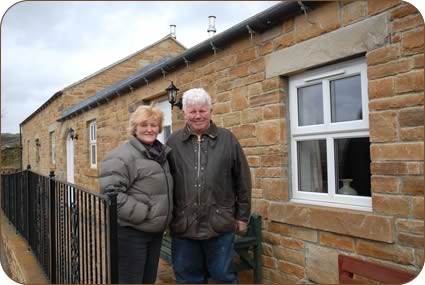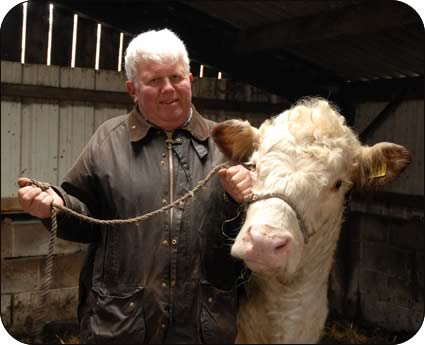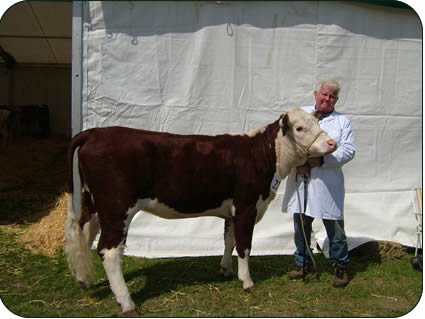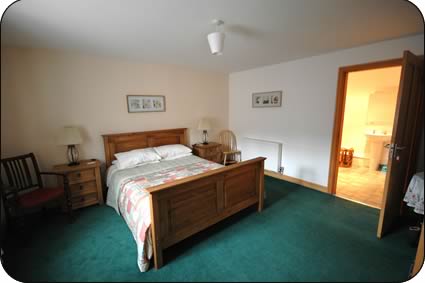Jennifer MacKenzie is an agricultural photo journalist with almost 30 year's experience. Operating from her base in Cumbria, Jennifer undertakes mainly industry-related freelance writing and photography.
Tourists and Herefords
A small farm high in the Pennine Dales of County Durham hosts many visitors
each year and is home to a herd of pedigree Hereford cattle.
When Jan and Harry Elliott took on Low Cornriggs Farm, Cowshill in Weardale
in 1989 the farmhouse was home to cattle and goats.
 |
| Jan and Harry Elliott outside the holiday cottages |
After much refurbishment over the years the farmhouse now offers bed and
breakfast at AA four star yellow rating (highly recommended and in the
top 10 per cent of the rating).
And two new holiday cottages, in their fourth season in 2009, are at the
highest rating by the English Tourist Board for self catering accommodation
with five stars.
The 30-acre farm runs to up to 1,800ft where the Hereford cattle graze
during the summer months – probably the highest kept Hereford herd
in the country.
The breed perfectly complements the Elliotts’ emphasis on looking
after the environment. All the farm is in an SSSI and the North Pennines
ESA.
The Elliotts ran Herefords commercially until about 10 years ago and when
they re-stocked after 2001’s foot and mouth epidemic they took the
opportunity to set up a pedigree herd.
They bought the best they could afford, initially five heifers from Ronald
and Robert Wilson’s Cartbog herd near Kelso.
That autumn the Elliotts had planned to go to the Canadian Beef Expo show
and the Wilsons kept the heifers until their return and even bulled them
with Critchley Figurehead.
They invested in a stock bull, Greenyards Ajax, the half brother of Greenyards
Archie, the Hereford Cattle Society’s bull of the year in 2007.
 |
| Harry with a young Hereford bull |
Now the Cornriggs herd numbers 13 females, six of the Elliotts’ own
breeding, and including six cows.
Harry is chairman of the North of England Hereford Breeders Association
which now boasts 53 members.
The breed’s docility and ease of handling is one of the attributes
attracting new breeders, particularly women, says Jan, who remembers the
predominance of the breed when she was a young girl in south Yorkshire.
“There is a big revival of interest in the breed,” said Harry. “A
lot of people are going for Herefords because of the eating qualities of
the meat and the marbling of the flesh and the fact that they are very
docile to look after.
“Traditionally, they were bred to produce tallow and fat as well
and people think of the meat as being fat but today’s genetics are
aimed at producing quality meat.
“Our cows thrive during the summer on traditional meadow allotments
at almost 2,000 ft above sea level.”
The cows are very fertile and easy calving - there has been no need to
assist any calvings in six years.
The cows go to the summer grazing a mile and a half away from the farm
steading at the beginning of May where they calve in September, weather
permitting returning to the farm in October.
Animals not retained for breeding are slaughtered at the local abattoir
and then are sold to a waiting list of customers in 15kg boxes of a variety
of cuts.
Because of the environmental constraints of the farm where meadows are
home to important species of flora and fauna, the Hereford herd number
is now at its optimum although it will be developed through progressive
breeding.
While just a small number of pedigrees have been sold for breeding, an
Ajax sired heifer made 1,500gns at the last sale in Carlisle. There are
two heifers and a bull to be entered for the May Carlisle sale.
 |
| Harry with a show heifer |
The Elliotts have started showing their pedigree Herefords helped by 14
year old Richard Dent – proof of the animals’ docility. Last
year the herd picked up a first and a third ticket at both Penrith and
Stanhope shows in the native breeds classes.
Jan comes from a family of butchers and bakers, so preparing what she describes
as ‘country fare’ for her visitors is second nature.
She has won the Pie Award made by the AA for quality breakfasts and evening
meals since 2000 and the farmhouse, which has three en-suite double rooms,
is in the Michelin B&B guide.
Harry is also showing his prowess in the kitchen equalling Jan’s
bronze medal in the National Marmalade Day held at Dalemain near Penrith
in February. Jan won her medal in the bed and breakfast section while Harry’s
was in the Man-made category. Among his repertoire of mainly sweet dishes
is a Tiramisu.
 |
| A spacious bedroom and ensuite in one of the holiday cottages |
The bed and breakfast business attractors guests year-round, particularly
during the winter when it snows as there are three ski tows within a nine
mile radius.
Among them are people from abroad tracing their ancestral heritage in the
dales.
When keen horsewoman Jan decided to close her riding stables at Low Cornriggs
six years ago the redundant building was knocked down to provide the two
purpose built holiday cottages with wide views across the valley.
Each cottage has three large bedrooms each with bathroom and shower room
and full facilities for the disabled as well as lounge and fully fitted
kitchen, catering for either weekly or short bookings.
Both the B&B business and the cottages have achieved a silver award
from the Green Tourism Business Scheme for the level of recycling carried
out.

